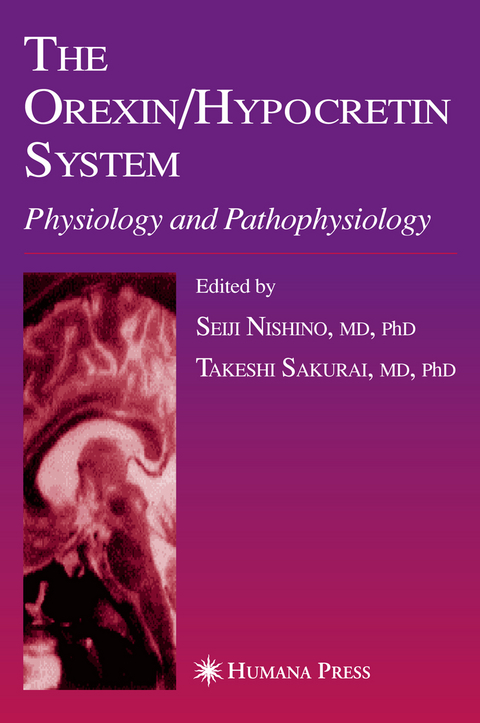
The Orexin/Hypocretin System
Humana Press Inc. (Verlag)
978-1-58829-444-9 (ISBN)
Orexin/hypocretin research began in 1998, as a result of the discovery of a new hypothalamic neuropeptide. In 1999, it was found that mutations in the orexin/ hypocretin-related genes caused a sleep disorder (narcolepsy) in dogs and mice. These findings were soon followed by the discoveries of orexin/hypocretin ligand deficiency in human narcolepsy. The finding of the major pathophysiological mechanisms of human narcolepsy resulted in its reclassification as a neurological, not a psychiatric, disorder. The - portance of early diagnosis and initiation of treatment for human narcolepsy has been repeatedly emphasized because the disease typically starts around puberty (when social and school influences become important). Orexin/hypocretin de- ciency in narcolepsy subjects can be detected clinically in cerebrospinal fluid (CSF) orexin/hypocretin measures (low CSF orexin/hypocretin levels are strongly asso- ated with narcolepsy-cataplexy among various neurologic and sleep disorders). Thus, the CSF orexin/hypocretin measurements are expected to be included as a diagnostic test for narcolepsy-cataplexy in the second revision of international di- nostic criteria (ICSD).
This positive diagnostic test is very useful for establishing an early diagnosis for narcolepsy-cataplexy, and many patients will likely receive im- diate benefits. Cerebrospinal orexin/hypocretin measurements are also informative for the nosological classification of hypersomnia. Because orexin/hypocretin de- ciency is observed in most human narcolepsy-cataplexy, orexin/hypocretin repla- ment therapy is now a promising new choice for the treatment of human narcolepsy, and research in this area is actively in progress.
History.- History and Overview of Orexin/Hypocretin Research.- Overview of the Orexin/Hypocretin Neuronal System.- Orexin and Orexin Receptors.- Orexin Projections and Localization of Orexin Receptors.- Neuronal Responses to Hypocretin/Orexin.- Afferent System of Orexin Neurons.- Assessment of Orexin/Hypocretin Functions in Tissue and Biological Fluids.- Hypocretin Measurements in the CSF, and Blood and Brain Tissue.- Hypocretin Receptor-Activated G Proteins Revealed by [35S]GTP?S Autoradiography.- Physiology.- Orexin System and Feeding Behavior.- Orexins and the Autonomic Nervous System.- Neuroendocrine Role of the Orexins (Hypocretins).- The Orexin/Hypocretin System and Stress and Emotion.- Physiology.- Hypocretin as a Wakefulness Regulatory Peptide.- Hypocretin/Orexin Tonus and Vigilance Control.- Hypocretin System and Aminergic and Cholinergic Systems in the Control of Vigilance.- Orexin and Hypothalamic Control of Sleep and Waking.- Hypocretin/Orexin and Motor Function.- Pathophysiology: Narcolepsy and Orexin/Hypocretin Deficiency.- Overview of Human Narcolepsy.- Canine Models of Narcolepsy.- Rodent Models of Human Narcolepsy-Cataplexy.- Pathophysiology: Narcolepsy and Orexin/Hypocretin Deficiency.- Hypocretin Deficiency in Human Narcolepsy.- Hypocretin Status in Neurological Disorders in Relation to Excessive Sleepiness and Cataplexy.- Hypocretin Measures in Psychiatric Disorders.- Neuroendocrinology of Human Narcolepsy.- Narcolepsy and Autoimmunity.- Pathophysiology: Narcolepsy and Orexin/Hypocretin Deficiency.- Pharmacology of Hypocretin/Orexin Peptides and Small Molecules.- Rescue of Narcoleptic Orexin Neuron-Ablated Mice by Ectopic Overexpression of Orexin Peptides.- Hypocretin/Orexin Replacement Therapy in Hypocretin/Orexin-Deficient Narcolepsy.
| Erscheint lt. Verlag | 15.8.2005 |
|---|---|
| Reihe/Serie | Contemporary Clinical Neuroscience |
| Zusatzinfo | 9 Illustrations, color; 142 Illustrations, black and white; 416 p. 151 illus., 9 illus. in color. |
| Verlagsort | Totowa, NJ |
| Sprache | englisch |
| Maße | 178 x 254 mm |
| Themenwelt | Medizin / Pharmazie ► Medizinische Fachgebiete ► Neurologie |
| Medizin / Pharmazie ► Studium | |
| Naturwissenschaften ► Biologie ► Humanbiologie | |
| ISBN-10 | 1-58829-444-7 / 1588294447 |
| ISBN-13 | 978-1-58829-444-9 / 9781588294449 |
| Zustand | Neuware |
| Haben Sie eine Frage zum Produkt? |
aus dem Bereich


